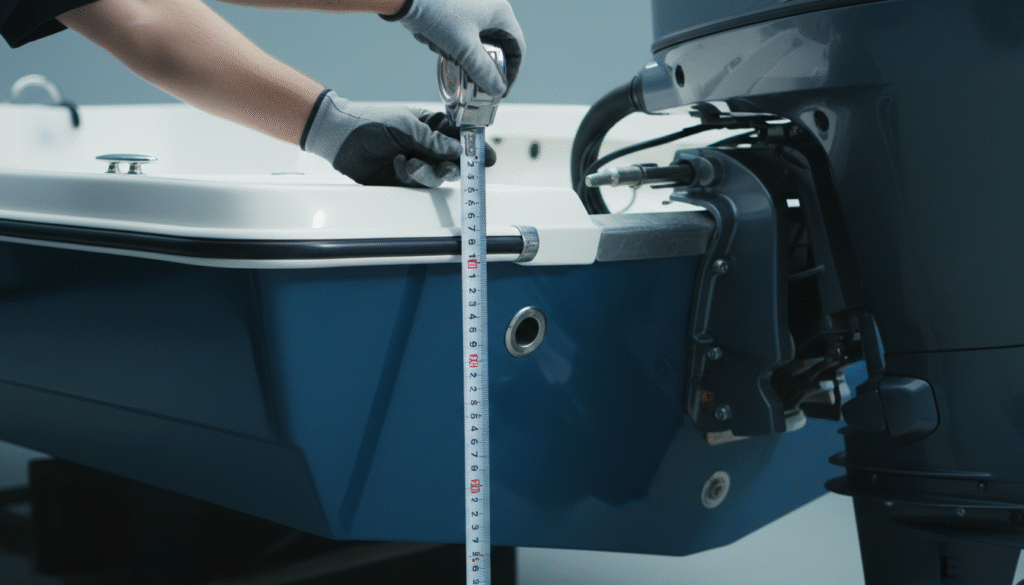Choosing the right outboard motor involves more than just horsepower. The single most important measurement for ensuring proper performance is the shaft length. This guide provides the complete, no-nonsense instructions to measure your boat correctly so you can buy with confidence. Learn the correct way to measure your boat’s transom in under 5 minutes to ensure you choose the perfect outboard shaft length.
Why Outboard Shaft Length is Critical for Performance
The shaft length of your outboard motor is a critical specification that directly impacts your boat’s handling, speed, and engine health. Its purpose is to position the propeller at the ideal depth in the water, just below the hull.
A correct fit ensures the propeller gets a clean “bite” of undisturbed water, providing optimal thrust and efficiency. Choosing the wrong length will lead to poor performance at best and expensive engine or boat damage at worst. Getting this measurement right is a non-negotiable step before purchasing a motor.
Standard Outboard Motor Shaft Lengths
Outboard motors are manufactured in several standard shaft lengths to fit a variety of boat transoms. While these are industry standards, you should always confirm the exact measurement with the motor’s manufacturer specifications.
- Short Shaft (S): 15 inches (approx. 38 cm)
- Long Shaft (L): 20 inches (approx. 51 cm)
- Extra Long (XL): 25 inches (approx. 64 cm)
- Ultra Long (XXL): 30 inches (approx. 76 cm)
How to Measure Your Boat’s Transom Height in 3 Steps
This simple process requires only a standard tape measure and gives you the exact number you need to select the right motor.
- Step 1: Locate the Motor Mounting Point. Find the top edge of the transom, which is the flat, reinforced rear wall of your boat where the outboard’s clamp brackets will attach.
- Step 2: Measure Down to the Keel. Run your tape measure straight down from this mounting point to the very bottom of the hull. Do not measure at an angle.
- Step 3: Record the Measurement. The number you see in inches is your boat’s transom height. This is the key measurement for selecting your shaft length.
Matching Your Transom Height to the Correct Shaft Length
Use your transom height measurement to find the corresponding standard shaft length. The goal is to have the motor’s anti-cavitation plate sit level with or just slightly below the bottom of the hull.
- If your transom measures 14-17 inches, you need a Short (15″) Shaft.
- If your transom measures 18-22 inches, you need a Long (20″) Shaft.
- If your transom measures 23-27 inches, you need an Extra Long (25″) Shaft.
Bizonytalan vagy? Find the right shaft length for your boat in our outboard motor selection.
What Happens if the Shaft is Too Short or Too Long?
Choosing the wrong shaft length leads to significant and immediate problems.
- Too Short: The propeller will be too close to the surface and will suck in air as it spins. This is called ventilation or “cavitation.” It causes a dramatic loss of power, over-revving of the engine, and potential overheating due to poor water intake.
- Too Long: The motor will sit too deep in the water. This creates excessive drag, which reduces top speed and hurts fuel efficiency. It also dramatically increases the risk of the lower unit striking underwater obstacles or the bottom in shallow water, leading to costly damage.
Special Considerations for Different Boat Types
While measuring is the only way to be certain, different boat styles typically use specific shaft lengths.
- Most small jon boats, aluminum fishing boats, and inflatable dinghies use a short shaft.
- Sailboats, which often have high transoms and auxiliary motor brackets, frequently require an extra-long or ultra-long shaft.
- Always measure your specific boat. Do not rely on the boat type alone to make a purchasing decision.
Frequently Asked Questions
How do you measure the shaft length on an outboard motor itself?
To measure the motor, run a tape measure from the inside top of the bracket that rests on the transom down to the anti-cavitation plate (the flat plate just above the propeller). This distance is the motor’s shaft length.
Can you use a long shaft outboard on a short transom boat?
It is not recommended. A long shaft on a short transom creates excessive drag, reduces performance, and puts the motor at high risk of being damaged by hitting the bottom or submerged objects.
Are outboard motor shaft lengths universal for all brands?
Yes, the standard lengths (15″, 20″, 25″, 30″) are generally consistent across major brands like Yamaha, Mercury, and Suzuki. However, it is always best practice to check the official specs for the specific model you are considering.
What is a 20 inch shaft called?
A 20-inch shaft is universally referred to as a “long shaft.”
Does shaft length affect the price of an outboard motor?
Yes, typically as the shaft length increases, the price of the motor also increases slightly due to the additional materials required for manufacturing.
Getting the measurement right is the first step. The next is finding the perfect motor for your needs. With the biggest selection of all major brands in the USA and expert support available to verify your measurements, we have the outboard you need for any boat. We offer multiple payment options, including financing and cryptocurrency.

